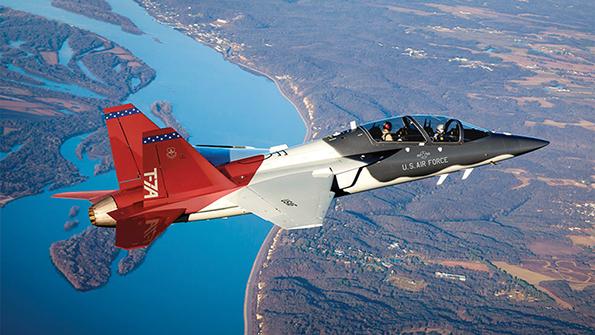Opinion: ‘Intershoring’ Will Change U.S. Defense Contracting

What if global moves toward protectionism actually lead to greater foreign involvement in the U.S. defense industrial base?
The U.S. has found itself in geopolitical tension with other countries that has led to trade disputes and higher levels of protectionist behavior. Many of these issues revolve around the U.S.-China relationship, but other Western and European countries fall into such geopolitical situations as well. The trade disputes and protectionist behavior started under the Trump administration have continued under the Biden administration’s reenforcement. “Buy American” proclamations, whether in the pure sense of U.S.-owned companies—or those with employees in the U.S.—appear to be multiplying.
Non-U.S. companies are not letting this distract them from pursuing U.S. defense subcontracting opportunities. At the recent annual Air Force Association conference in Washington, one-third of the 36 big manufacturing exhibitors were foreign-owned with U.S.-run businesses. Industry analysts report similar takeaways from the Association of the U.S. Army convention that followed.
In the 1990s and early 2000s, U.S. companies progressively offshored work to cut labor costs and to be closer logistically to raw-material-providing suppliers and subassembly customers. Some countries, with their own emerging markets and aircraft demand, were targeted by the major airframers to meet local content requirements. And U.S. companies using this strategy enjoyed U.S. government tax offsets and foreign tax benefits.
Over the last decade in these overseas locations, however, tax benefits have expired, labor and total costs have increased, and new manufacturing risks have emerged. In response, U.S. companies have begun dual-sourcing, insourcing and reshoring efforts to bring manufacturing back to the U.S. Hidden costs—of poor quality, logistics, learning curves on new product manufacturing and intellectual property protection—have been factored into business plans and financial results.
The growing trend now in manufacturing strategy, which I call “intershoring,” involves international companies setting up manufacturing operations in the U.S. to take advantage, directly and indirectly, of domestic U.S. government contracting opportunities.
Intershoring is a new term, but it is not a new trend. Such efforts in recent decades were focused on Boeing’s commercial aerospace sector and proximity to its U.S. assembly plants. More recently, companies such as Saab have established new, cutting-edge manufacturing facilities in the U.S. and could become significant contributors to U.S. government contracting.
Soon a large share of the new U.S. Air Force T-7A fighter trainer will be manufactured by a U.S.-based Saab-Boeing partnership. The aft section will be built by Saab in West Lafayette, Indiana, then sent to Boeing for final assembly in St. Louis.
Saab’s new “smart factory” in West Lafayette allows internal systems to communicate and generate data to streamline operations, tapping equipment simulation, information technology systems and factory metrics to increase automation at lower costs. Saab has also positioned its business to receive economic development incentives from job-training initiatives and government grants for skills training, and it is leveraging nearby academic institutions, such as Purdue University, to conduct joint research.
Saab may not be a prime contractor on the T-7A, but with the amount of content it is providing on the aircraft and the new factory and government activities being pursued, its principal-subcontractor role is extremely important.
Intershoring could be growing among international defense contractors for several reasons. First, the U.S. defense market has very large contract opportunities for major platforms. Second, the government offers incentives for companies to establish manufacturing facilities in the U.S.—foreign direct investment in the U.S. for Defense Department contracts. Third, universities and local government partnerships provide attractive incentives.
Many contracts have “Made in America” requirements. According to consultancy Govini, the number of foreign companies becoming U.S. government contractors grew to 17,000 in 2019 from about 5,000 in 2013. Additionally, the U.S. is becoming an optimal place for international investment because of favorable exchange rates for the dollar.
Despite protectionism and trade disputes with other countries, the wave of companies from abroad wanting to enter the U.S. defense and space market will continue to grow. American companies need to take notice. This intershoring strategy is just getting started.
Alex Krutz is managing director at Patriot Industrial Partners, an aerospace and defense advisory firm that focuses on manufacturing strategy and supply chain optimization.
The views expressed are not necessarily those of Aviation Week.




